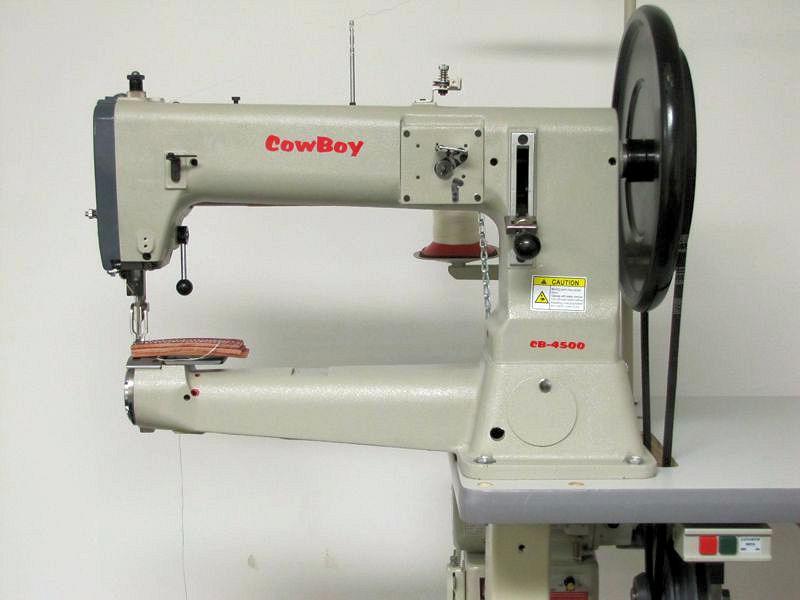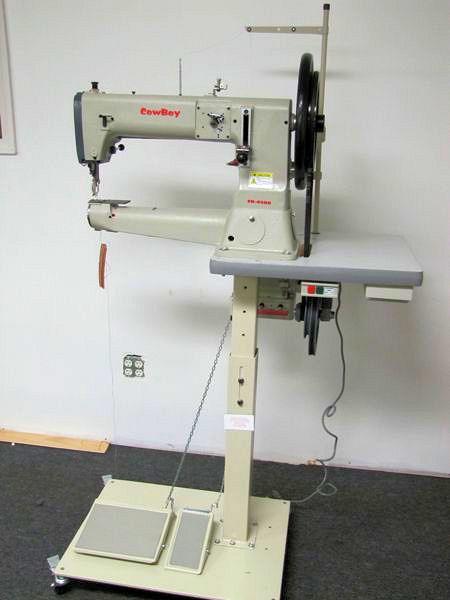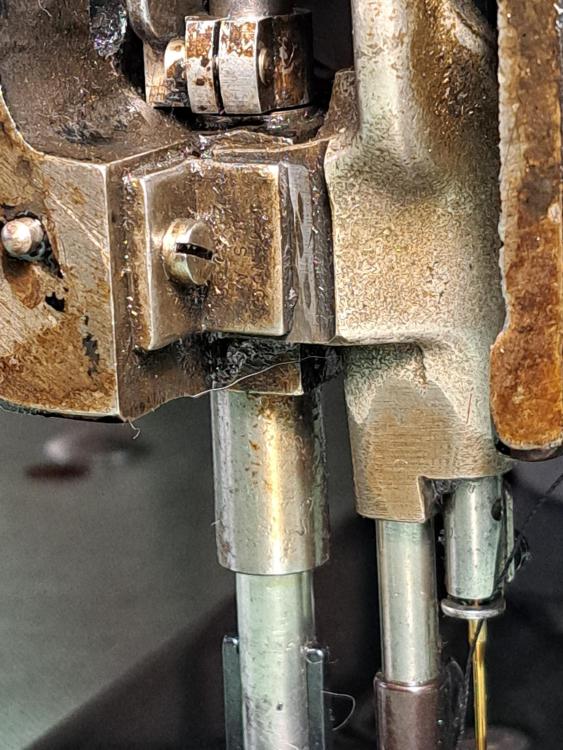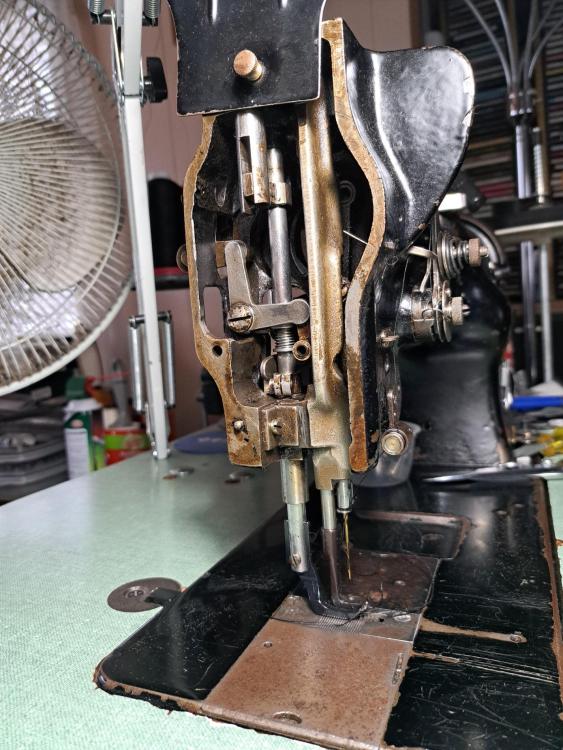-
Posts
7,776 -
Joined
-
Last visited
Content Type
Profiles
Forums
Events
Blogs
Gallery
Everything posted by Wizcrafts
-

Binding with a right angle binder on a walking foot machine
Wizcrafts replied to Dave9111's topic in Leather Sewing Machines
Bring some of your material with you. Have them try to bind it with their tape and binder. Then, let us know how it plays out. -

Binding with a right angle binder on a walking foot machine
Wizcrafts replied to Dave9111's topic in Leather Sewing Machines
@Dave9111 Have you tried contacting Sailrite using their online chat? They deal with people sewing canvas and nylon. All of their machines have special binder attachments available that work with the bias tape they sell. This ain't yo Momma's bias tape either. Some of it is made out of canvas. They sell Sunbrella and matching bias tape. Chances are that their folders and tapes will get your jobs done correctly. Here is one of the Sailrite videos demonstrating how to sew both inside and outside 90 degree turns using Sunbrella bias tape and fabric. -

Parts for old Singer Industrial sewing machines - where?
Wizcrafts replied to customizer's topic in Leather Sewing Machines
It is very unlikely that there are any dealers with the original parts for a Singer 18-3. That series was made in the 1920s and 30s. Singer's industrial division has been out of business for a long time. They sold off all of the remaining parts to various dealers. Still, the chance that some dealer, somewhere has that part is above zero percent. Parts can also be salvaged from another machine if you can find one. -
Those are not industrial leather sewing machines. They are domestic, or household hobbyist sewing machines. They are neither heavy duty, nor meant for leather. This is the wrong forum to get information about domestic sewing machines. I posted a picture below of a real heavy duty leather sewing machine as a reference. It can sew over 3/4 inch of hard leather with needles as large as roofing nails and thread 10 times thicker than anything the domestic machines can handle..
-

Binding with a right angle binder on a walking foot machine
Wizcrafts replied to Dave9111's topic in Leather Sewing Machines
@Dave9111; Many years aago I had a sew ing gig that required me to sew binding onto the edges of road workers' safety vgave ding run off the top or bottom on turns, especially inside turns. The vests had outside and inside curves. I tried inexpensive oriental binders, but they let the bindinsg run off the top or bottom on inside curves. My dealer recommended getting a custom binder made by a specialist. It cost the boss $400 for that binder, but it worked flawlessly. If you aren't getting satisfactory results with a stock binder, look into a custom made binder that's made to work with a particular binding material. The right angle binder I had made double-folded binding out of flat 1.25 inch polyester edge tape. -
@SaraJ There is a possible explanation for your sideways needle bar motion. That could be caused by a loose or misadjusted L shaped bracket at the bottom of the head, on the left end. This bracket secures the needle bar, inside (aka: alternating/vibrating) foot bar and presser bar, keeping them aligned laterally. Here are two photos showing the wide and close=up view of the parts. My machine is a flatbed 111, but the mechanism is the same on your Singer 153. The screw secures the bracket. The hole in the bracket is wider than the screw. This lets it move to the right and left to set the clearance to a minimum, or maximum, as desired by the user. Try tightening it while pushing it to the right. But, don't let it bind the shafts. They must move freely, but without noticeably shifting to the right or left.
-

Machine for alcantara and other textiles, no leather.
Wizcrafts replied to DvidSnchez's topic in Leather Sewing Machines
The Juki 8700 is a bottom feed only machine. You will have to either order one with the most aggressive teeth, or buy an aftermarket feed dog with aggressive teeth if you're to have any hope of the moving the material. Really, auto upholstery, like any other type of upholstery, calls for a walking foot machine, with at least dual feed. The Sailrite portables all have top and bottom feed. The Consew 206 series machines all have triple/compound feed, which is the strongest and keeps all layers aligned as the needle move with the feed dog and the inside foot. You may be able to find a used Singer, Consew or Juki walking foot machine, complete with a table and motor, well within your stated budget. -

When does the thread advance off the spool and bobbin
Wizcrafts replied to Lint's topic in Leather Sewing Machines
It is always best to feed spooled thread off the top. Feeding sideways adds unpredictable friction that changes as the spool unwinds. If you need a thread stand, buy one. They come with raised bottom plates that screw onto a table. The stand threads into the plate and there are usually two cone brackets, and thread loops above them. -
@Cumberland Highpower I just remembered about another machine that had a jump foot AND needle feed. It was called the Number 9. It disappeared in the mid 20th Century, then was reborn as the Luberto Classic. This then disappeared about 10 years ago. These were heavy duty harness stitchers, not well suited to delicate work. Both used a really long needle system that could deflect in the thinner sizes (for thinner thread).
-
I don't know. I only had a 204-374 flatbed. Weaver used to sell the 205 models. Ask somebody who still owns one.
-

Pfaff 3334 Y-Axis adjustment
Wizcrafts replied to greatwhitetrading's topic in Leather Sewing Machines
How did you get the pattern centered in both axis'? Others may want to know. -
I had a 204-374 for a short time in 2010. It had a smooth feed dog. The -370 feed dog has teeth. This also applies to the Adler 205 machines. The -370 has teeth and the -374 has a smooth feeder.
-
My guess is that the gears are worn beyond their ability to time the machine within specs. Or, the driving pinion gear might be loose on the shaft that has the shuttle driver on top. There is a small set screw that's accessible from the rear side of the nose, via a hole. If you line up the gear just right you can get a small blade screw driver on it and tighten it if it was loose. That would be the cheapest fix. It's unusual for the eccentric screw under the main body to get worn out, but hey... Flakey sewing is often caused by a worn paddle spring. If there is a thread channel gouged into the spring, or the needle bar, then the loop will dissolve before pick-off time.
-

troubles with cb3500 threading on upper tension
Wizcrafts replied to TonyGreen3455's topic in Leather Sewing Machines
Here's one part of the problem of thread coming out of tensioners. I found out that not every spool of thread unwinds smoothly. Some, especially black thread spools are what I call "twisty or coily." They unwind with a twist that's in the direction they were wound in. The worst offender is from Weaver. Sometimes, thread is double-dyed to get a solid black color. This really stiffens the thread and can cause it to become a coil that twists around guides and jumps out of tensioners. I have come up with a way to counteract this twist. This is specific to the Cowboy and Cobra 441 clones, and similar machines that have a top guide post containing at least two holes that are about an inch apart. My solution is to feed the top thread through the top hole, then turn it counterclockwise and feed it through the bottom hole. From there, it goes to the eyelet under the tension disks. I also lowered that eyelet to get a tighter feed into the disks. I've never tried feeding the thread back through that eyelet because my reverse feed seems to counteract the twisty thread. -
You can view the picture on FB and long press or right click to reveal the option to download and save it. Then upload the saved photo in a reply, reducing the filesize as necessary. There are various utilities/apps for resizing photos.
-

Sheepskin jacket leather sewing machine
Wizcrafts replied to thesoi6's topic in Leather Sewing Machines
That machine does have a walking foot system called dual feed. The feed dog and presser foot move together. The stitch length can vary with the thickness. and layers could separate. Sailrite offers a version of their machine they call "The Leatherworker." It has knurled teeth on the feet to minimize marking the top of the leather. They also have upgrades that include a heavy flywheel and "WorkerB" motor for better punching power. By the time you upgrade that machine, you could buy a Consew 206RB-5, which is a full industrial compound feed walking foot machine. -

Sheepskin jacket leather sewing machine
Wizcrafts replied to thesoi6's topic in Leather Sewing Machines
There is no such thing as a semi-industrial sewing machine. That's a marketing term created by eBay sellers. ;-) The Juki in the video is a portable bottom feed machine, which was marketed to quilters. it could possibly okay for your work because the bottom of the skins can be gripped by the feed dog teeth. If you look closely at the video, you'll' see that the machine has a Teflon presser foot to help it glide without grabbing the top layer. It has a built in motor, similar to other domestic sewing machines and even uses standard household sewing machine needles. This would limit the maximum thickness to about 1/4 inch of soft to medium temper material. It might have trouble feeding reliably if your skins get heavy when butted together for sewing. -
First, the Consew model you have is a mini-walking foot machine with top and bottom feed..It is similar to the Sailrite mini-walkers that are used in boat upholstery and sail repairs. Second, Your combination of needle and thread is mismatched. Number 69 (aka: T70) thread calls for a #18 needle. Number 92 thread calls for a #19 needle. Number 138 thread requires either a #22 or 23 needle, depending on what type of material you are sewing. Your number 21 needles are too big for your thread and too small for #138 that you want to buy. To be fair, number 21 needles are probably a good fit for #105 thread, which is rare and is sometimes used to sew denim clothing. Third, your machine's foot lift under power is only 5/16 inch thickness. That would be soft material, like sailcloth, denim, or marine vinyl. Practically, you should limit the thickness to 1/4 inch. You can probably buy accessories and upgrades from Sailrite. They also have some very informative videos.
-
There are newer mini motors that have at least twice the power of the originals from yesteryear. They should be paired with a new electronically controlled speed pedal. You'll have all new wiring that shouldn't overheat and burn up like the old wiring tends to do after 50 or more years. You can find combos of a high power motor and matching control pedal on eBay and Amazon. Look for one compatible with your Singer 15k. Or, PM me if you need help finding the proper pedal. Your wall connector will be different that ours in the USA.
-
The 15 class machines are bottom fed only. The presser foot's job is to hold down the material as the needle ascends. The feed dogs come up from the bottom and push the material backwards; away from you. If the material is heavy, as is leather, the feed dog teeth might slip due to the pressure exerted on top by the presser foot. This causes the stitch length to vary, or be unpredictable. You might thing that you'll just back off the pressure screw on top to make it easier to feed the leather. That might help to a certain point, which is reached when the leather starts lifting with the ascending needle. This causes skipped stitches, and, possibly, even a broken or bent needle. In order to overcome the feeding problems of bottom fed machines, some people equip their sewing machines with roller feet. and a matching inline feed dog and throat plate. All of this will be moot if the tiny motor is unable to power the machine as it tries to penetrate and feed the leather. It was this problem that led to the development of the class 15 industrial swing machines. These machines came out in the early 20th Century. The Singer 31-15 was popular with tailor shops, alterationists, costume makers, and garment factories.. If you bought this domestic machine with the intention of sewing leather, I recommend that you read my pinned topic about the type of sewing machine you need to sew leather.
-
@jezzell First of all, #277 is too thick for 8 ounces of leather. Move down to #207, on top and in the bobbin. Your #24 needles is the right size for #207 thread, not 277. That calls for a #25/200 needle. I you insist on having 277 on top, at least wind a bobbin with #207. Then the #24 needles may work better. The next issue is the shape of the needle. You seem to be using an S point needle that causes the edges to be pulled into the leather, shortening the appearance. Get you some diamond or tri-point needles. They let the stitches stay on the surface on both ends.
-
Can you upload a picture of the current roller edge guide?
-
@Dwight That's a whole nuther aspect of sewing patches than I described. You'll be sewing cloth patches onto cloth garments. The garments will be much more flexible than leather vests. You'll probably be using a lot of Olive Drab 50 weight garment sewing thread. That calls for a #14 needle and a gentle machine. A singer patcher will handle the job, as will a post bed machine. The Chinese shoe patches are pretty rough in the castings and will need to be gone over with Emory cloth to smooth out any rough spots that could cut the cloth. FWIIW, my Daddy was a tailor. For the longest time we had the tailor shop on the ground floor where the 5th Army was housed. He sewed patches onto uniforms and dress shirts. I removed the old ones for him. He sewed every patch on a Singer 31-15 straight stitch machine. I think he hand sewed the ones on sleeves. He didn't know about patchers. That's something I accidentally fell into. In case you weren't aware, patchers are top fed by the teeth on the presser foot. There is a small hole in the needle plate, which is polished steel. All true patchers have butterfly handles to rotate the foot over 360 degrees. Whatever machine you end up getting, learn to reduce the foot pressure and thread tensions to avoid damaging the patches or cloth garments. Typically, patchers are built and setup to sew shoe leather, not cotton shirts.






